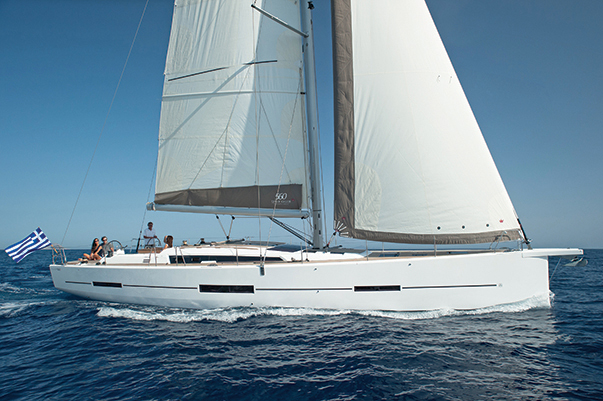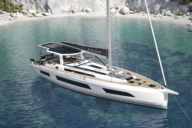The spinnaker had just filled and was getting trimmed when someone hollered, “Heat it up!” I obliged from the windward helm and then watched our boatspeed jump while I brought us closer to the wind—three and a half knots quickly became five, then seven, then eight.
This was our second spinnaker set of the day and the evening breeze was filling in nicely on the Pacific Ocean off Venice Beach, California. The Wednesday night Sunset Racing Series was going on in our midst and normally laser-focused racers were turning their heads to watch us go by. We weren’t doing anything special, the new 560 is just a real looker.
 It is always a treat to spend more than a few hours learning about a new boat, which was the case in late August when I met Eric Macklin from Dufour Yachts in Marina Del Rey to sail and learn about the company’s big new beauty, the 560.
It is always a treat to spend more than a few hours learning about a new boat, which was the case in late August when I met Eric Macklin from Dufour Yachts in Marina Del Rey to sail and learn about the company’s big new beauty, the 560.
SAILING PERFORMANCE
Before stepping aboard, Eric explained that while Dufour’s philosophy is to build boats for cruisers first, performance is of prime importance to all of their models, and the new 560 is no exception.
With a crew of about 10 people, we hit the water during two separate sailing sessions, afternoon and evening. Each time, we motored quickly out of the marina to the breakwater where we set the in-mast furling mainsail and self-tacking jib. During our afternoon sail we had a steady eight to 10 knot westerly breeze and by the evening it had filled in to around 12 to 15 knots. Once the engine was shut down, the five-blade Max Prop feathered and we quickly put the channel behind us as we brought the 560 up on the wind and trimmed accordingly.
As we sailed upwind towards Malibu in the distance, the first thing that caught my eye was the tight sheeting angle of the jib. It was a thing of beauty. And when it was my turn at the helm I sat to leeward and played with the telltales, feathering at about a 40-degree apparent wind angle and topping out at 7.6 knots of boatspeed. I could tell that the 560’s eight foot two inch draft was helping our upwind performance, and the smaller in-mast furling main didn’t seem to detract from our overall speed or pointing ability.
While sailing upwind in the fresher afternoon breeze, we healed to about 15 degrees and locked in on the boat’s hard chine, which runs nearly the length of the boat. When a gust would hit it seemed as though it might go further over, but it never did. You hear people say that some big boats sail like a dinghy, and that’s what everyone seemed to be repeating as we rotated through. The helm was light and steering was effortless.
With the self-tacking jib, every maneuver was dead simple. It was all helmsman. Whoever was on the helm would jokingly call the tack and bring the boat through the wind—no adjusting sheets, just steering.
After putting the boat through a series of graceful tacks and trying to best each other’s upwind speeds, we got the spinnaker rigged at the bow from the forward sail locker and cracked off for a set. Normally the 560 would fly a furling A-sail from the integral bowsprit, but the type of sail and color is an owner’s option so we had a borrowed cruising spinnaker in a sock.
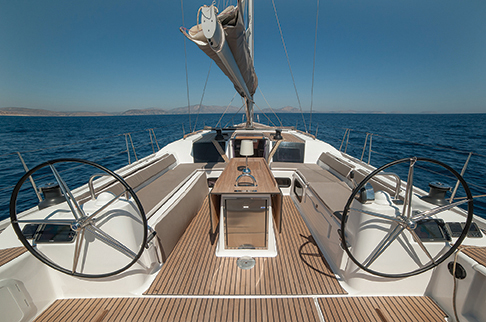 We set the spinnaker during both sailing sessions, but in the increased afternoon breeze she really came into her own. Acceleration was immediate and, thanks to the electric winches, trimming the sheets was easy in all the wind conditions we encountered. Jibing took a little more coordination, but our very able crew made quick work of the task. Just as in a tack, the boat scooted forward quickly after each jibe was complete and the spinnaker was trimmed. And though we weren’t out racing with the Wednesday night fleet, we certainly looked like we could have been.
We set the spinnaker during both sailing sessions, but in the increased afternoon breeze she really came into her own. Acceleration was immediate and, thanks to the electric winches, trimming the sheets was easy in all the wind conditions we encountered. Jibing took a little more coordination, but our very able crew made quick work of the task. Just as in a tack, the boat scooted forward quickly after each jibe was complete and the spinnaker was trimmed. And though we weren’t out racing with the Wednesday night fleet, we certainly looked like we could have been.
UNDER POWER
The 560 comes standard with a 110 horespower Volvo diesel with the option for a 150. Our test boat had the 110 and it seemed more than adequate as we motored out of the marina and toward the Pacific. At 1200 rpms we were having a hard time staying under the five knot speed limit and when we opened it up, 2500 rpms got us well over eight and at a max of 3000 we hit nine knots briefly before throttling back.
The throttle and gears are electronic, not cable, which takes a little getting used to when coming alongside a dock in a stiff breeze. But once you’ve got the touch and feel of it mastered, you wouldn’t want it any other way.
With a single, deep rudder the helm responded quickly to minimal and drastic helm adjustments and the boat could easily be spun in her own length. Of course, a bow thruster helps immensely and the 560 doesn’t have any ordinary bow thruster. The thruster is actually retractable and drops down from a small door in the bow, which puts it lower in the water and creates more side-to-side thrust. This was quickly obvious when we used it to free us from our starboard side tie and when someone remarked that it felt like an outboard engine on the bow, I couldn’t help but chuckle in agreement.
DECK, COCKPIT & SAIL HANDLING
Modern and sleek, the 560’s deck profile is nearly flush forward of the mast with a slightly raised cabin top aft. And in honor of the company’s 50th anniversary, the cabin windows harken back to their successful Arpege model from the mid-60s. The bow and stern are as close to plumb as you’ll see on any boat and the robust integral bowsprit, which is made of stainless and covered by fiberglass, gives the boat a functional yet sporty look. This is where you’ll tack your A-sail and it also houses an anchor roller and second auxiliary roller for a spare anchor or snubber line.
Just aft of the sprit is a low profile, flat deck furler by Facnor. A removable inner forestay is also an option and it would be a good one if you plan to take the boat on any extended offshore passages. An intriguing possibility for blue water would be to set the boat up with three furling headsails: a staysail that sheets to the self-tacking track, a larger jib that sheets back to the adjustable genoa tracks, and a top down furling A-sail for light wind and power reaching.
Walking forward or aft on deck you’ll quickly notice how wide the side decks are and how uncluttered they feel. There are minimal lines running aft to roll a foot on, as most are led through channels or are set close to the cabin top. And all the hatches are flush, which are clean looking and don’t create a trip hazard. Also, there is a large storage area forward for sails and other gear, which can be ordered as a skipper’s cabin.
The cockpit on the 560 is huge and exceptionally well thought-out for sail handling and living while underway or at anchor. Control lines and sheets are led aft through deck channels to recessed rope clutches and then to winches on either side of the companionway. There are also two electric winches aft near the helms that are easily within reach while steering. The double-ended mainsheet runs to these via clutches and if a larger jib was setup on the fairleads, this is where you’d run their sheets as well. With the amount and position of all the clutches and winches, sail handling is simple for one or two people at most.
A clever feature that was designed into the cockpit are several line bins built into the sole at the companionway and near the helms. These did a great job of keeping up with all the excess line, but I’m sure you’d want to empty and dry them out periodically to keep everything clean.
Over the past few decades cruising boat designers and builders have been keying in on the fact that we spend a lot, or the majority of, our time aboard in the cockpit. Big cockpits with ample seating are the modern norm and the 560 sets the bar extremely high for cockpit comfort. The port settee folds out to create a large, flat lounging area and then can fold up to create a sea berth while underway. The folding cockpit table is big enough to accommodate eight people and with a built in fridge aft, and ice bin in the middle, there is plenty of cold storage. Each helm has a seat that has been smartly curved to make it comfortable while the boat is heeling and places to brace your feet will keep you there.
The stern is the main attraction of the cockpit, though. A long, wide stern seat takes up the space behind the helms and at one point during our test sail we had six people happily sitting across it without being scrunched together. While at anchor, a large drop down transom can be lowered with the touch of a button and then the stern seat opens to reveal a mini galley. With a shallow sink, cooktop and counter space, this is a perfect spot to serve happy hour from or to whip up an appetizer, as we did while returning to the marina after our first sail. This is truly unique.
DOWN BELOW
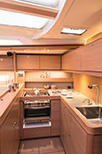 The style points keep coming when you drop down below on the 560. Available in mahogany or oak, the interior is well finished and conceived. Large flush deck hatches and windows overhead, coupled with the cabin top windows and non-opening ports along the hull throw plenty of light in from all angles. The boat we tested had the lighter oak finish and I’d find it hard to want to go any darker than that.
The style points keep coming when you drop down below on the 560. Available in mahogany or oak, the interior is well finished and conceived. Large flush deck hatches and windows overhead, coupled with the cabin top windows and non-opening ports along the hull throw plenty of light in from all angles. The boat we tested had the lighter oak finish and I’d find it hard to want to go any darker than that.
The standard layout is for three cabins, but options are available so you can get the best configuration for your needs. The massive forward cabin can be configured in three ways: with a Pullman berth, a centerline berth, or with a “side island” berth that is a unique combination of the two. And given its size and en-suite head and shower, this will certainly be the owner’s cabin.
 The two aft cabins are fairly large as well and heads and showers can be had with both or just one. An intriguing option for a family or those who sail with a large crew would be to add the optional bunkroom on the starboard side just forward of the starboard aft cabin. This would eliminate one head, but it would be worth it if you needed the extra berths. The table in the main saloon also turns into a large berth, so you won’t be lacking in sleeping space when you need it.
The two aft cabins are fairly large as well and heads and showers can be had with both or just one. An intriguing option for a family or those who sail with a large crew would be to add the optional bunkroom on the starboard side just forward of the starboard aft cabin. This would eliminate one head, but it would be worth it if you needed the extra berths. The table in the main saloon also turns into a large berth, so you won’t be lacking in sleeping space when you need it.
One of my favorite design aspects of the 560 is the forward galley. Set immediately in front of the saloon, the galley spans the width of the boat and is narrow enough to brace a hip on as you move about. And the amount of counter and storage space created by this setup is quite impressive. A standup fridge and freezer are to starboard with a three-burner stove and oven to port. In true modern Euro-styling, the galley is replete with a wine fridge and one of the overhead cupboards has a Nespresso machine with built-in racks for the espresso refills.
Because of the forward galley, you immediately enter the saloon as you come down the companionway. There is a long settee to starboard and a large, U-shaped settee to port with a sliding bench/island in the middle that adds a few seats and gives you something to brace against as you move forward and aft. I made it a point to go down below while we were underway, and, though the saloon is large and open, there are a number of well-placed handholds and the flooring offered a good grip underfoot.
On a boat of this size you’d expect to have a suitable amount of storage space and the 560 is no exception. Nearly everywhere you go no space is left unused. Below the companionway is a “wine cellar” and cabinets line both sides of the saloon. Drawers pull out from underneath bunks and there are several large hanging lockers for your foulies.

A dedicated nav station is to starboard with an articulating chartplotter overhead. The electric control panel fits neatly next to the desktop and there is plenty of space to add radios and phones. To power all your amenities, the boat can come with a generator and you are able to build a battery bank to suite your needs. Three tanks accommodate 180 gallons of water and for extended cruising you may look to add a watermaker.
DESIGN & BUILD
For the hull shape, Dufour went with the well known Italian firm, Felci Yacht Design. Highly regarded for their racing and one-design hulls, Felci gave the 560 a long waterline and hard chine that extends nearly the length of the boat. Dufours are built for cruisers first and what Felci came up with is a beamy boat that carries a lot of volume inside and out, but will still tick off the miles comfortably offshore.
The design ratios suggest a boat that pushes more towards the performance side of the spectrum, but the numbers don’t really tell the whole story about its sailing capabilities. Dufour was one of the first boat builders to use a bulb keel back in the 60s and they have worked hard to make sure that their underwater foils stay on the cutting edge. With an optional draft of eight feet two inches, or seven feet two inches, the cast iron keels have a large bulb to get weight lower in the water. Whether fitted with a standard or in-mast furling mainsail, the 560 will do quite well in light air with a large headsail, and when the breeze pipes up she should still stay on her feet, especially with the 85 percent jib.
The 560s construction is just as modern as her design. Built in La Rochelle, France, the boats have PVC core topsides with solid FRP below the waterlines. The hulls are molded with an inward-flanged deck joint for strength and to help eliminate pesky hull to deck joint leaks. All the structural bulkheads are fiberglass tabbed to the hull instead of just glued or epoxied. And chainplates are built into reinforcements in the hull.
BWS THOUGHTS
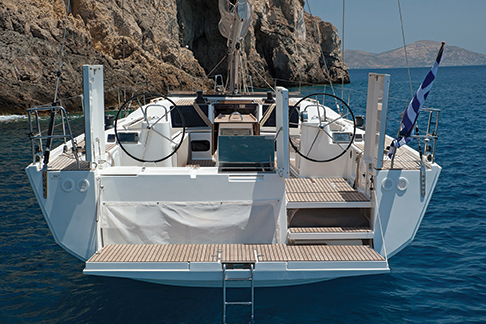 Being that Dufour Yachts has been around in some capacity for 50 years, it is pretty clear that they have been doing something right. In my estimation, that something is attention to detail and figuring out little unique features to set their boats apart from others (see: stern galley). While test sailing the new 560 I continually found myself making notes about intricacies built into the boat that I had never seen before. Sure, not everyone will want some of them, but I have to tip my cap to Dufour for thinking outside the normal parameters of what is currently on the market.
Being that Dufour Yachts has been around in some capacity for 50 years, it is pretty clear that they have been doing something right. In my estimation, that something is attention to detail and figuring out little unique features to set their boats apart from others (see: stern galley). While test sailing the new 560 I continually found myself making notes about intricacies built into the boat that I had never seen before. Sure, not everyone will want some of them, but I have to tip my cap to Dufour for thinking outside the normal parameters of what is currently on the market.
There is no mistaking it, the new 560 is a big boat. And while I worried at first that it might be intimidating for some, I don’t think that will end up being the case for long once you spend some time on the boat. The sheer size makes it a perfect candidate for a family cruising boat or for those who want to cruise comfortably with several couples. But while it is able to accommodate the whole clan, its ease of handling will still make it perfectly useable for a couple.
The 560 will be great as a coastal cruiser or live aboard and definitely has the capability to take you offshore in the mid-latitudes so you can explore all those tropical spots you’ve dreamed of. And once you’re there, you’ll probably be cooking a meal in your stern galley while watching the sunset and toasting with cold champagne from your wine fridge. Cheers.
by Andrew Cross
Dufour 560
Overall length – 56’3”
Hull length – 53’6”
Waterline length – 49’9”
Beam – 16’7”
Displacement – 17625kg
Draft – 8’2” or 7’2’’
Sail Area -152.7m²
Fuel tank capacity – 110 Gal
Water tank capacity -160 Gal
CE Certification – Category A
Dufour Yachts
eric.macklin@dufour-yachts.com
www.dufour-yachts.com

